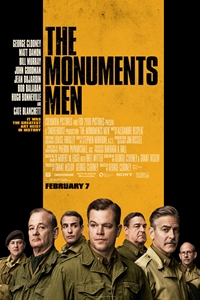 The Monuments Men
The Monuments Men
Starring George Clooney, Bill Murray, Matt Damon, John Goodman, Jean Dujardin, Bob Balaban, Hugh Bonneville and Cate Blanchett
Directed by George Clooney
From Columbia Pictures
Rated PG-13
118 minutes
Great scenes and performances save an otherwise clunky war drama
by Michael Clawson of Terminal Volume
There are many things The Monuments Men fumbles, including its stop-and-go pacing and fragmented plotlines, but what it gets right is rewarding enough to forgive many of its failures. The movie’s ultimate success is that it understands art on a profoundly deep level.
And not just knowledge of art — “here’s a Rembrandt, here’s a Monet, here’s a Renoir” — the film truly gets the concept of art and its importance to a people. In World War II, Hitler didn’t just want the world as a piece of real estate, he wanted every fiber, every micron of dust, every spinning electron. He wanted it all. That included all the art. “How do you erase a people? You not only kill them, but you erase their achievements,” someone says early in Monuments Men. After all, what is art but a collection of visualized hopes and dreams, fears and desires? Art isn’t canvas or marble or bronze, it’s an impassioned plea for immortality. Hitler, himself a failed artist, knew this and set out to sabotage it.
Pushing back are the Monuments Men, FDR’s super-team of art historians, dealers, architects, sculptors and painters. They’re captained by Frank Stokes (George Clooney), whose first order of business seems to be a movie montage as he recruits his team. I won’t bog you down with character names, because there are many, but the cast is top-notch: Bill Murray, Matt Damon, John Goodman, Jean Dujardin, Bob Balaban and Hugh Bonneville. Before they can go to Europe and save art, they have to go through basic training, which goes about as well as you would expect with this all-star team of actors. Murray shrugs over the obstacle course wall like a sack of potatoes. In a scene that drew big laughs, Goodman walks through a firing range not knowing the soldiers were using live rounds.
In Europe after D-Day, the Monuments Men quickly begin tracing down missing and stolen artwork, be it big museum pieces or smaller works ransacked from Jewish collectors’ homes. The Nazis used Paris, and much of Europe, like a shopping mall: they’d invade a country and top officials would pop in to get something to hang in their parlors. Several particular pieces are doted on, including Michelangelo’s marble Madonna and Child, Rembrandt’s self-portrait, several pieces by Johannes Vermeer, and the striking Ghent altarpiece, a magnificent 15th-century painting on a set of elaborate shutters. The team is also tasked with telling Allied soldiers what they can and can’t bomb, which is punctuated by a sequence showing Italian villagers shoring up the walls of the bombed-out church housing Leonardo da Vinci’s The Last Supper. I looked this piece of history up after the movie; Monuments Men did not embellish how close the famous mural came to crumbling.
The narrative structure of the movie is put together sloppily. Scenes just sorta happen, often times with little leading up to them and little leading after. It all feels disjointed and frenzied. The acting is terrific, as is the insightful and historically relevant dialogue, and the individual scenes are spectacular, including one of Damon returning a painting to an empty apartment, its Jewish occupants long since carted off to gas chambers. But looking at the film as a whole, its scenes forming its central mass, it needs work. Having so many plotlines — the Madonna, the Ghent altarpiece, a weasely Nazi named Stahl and Cate Blanchett playing a museum record keeper — gave us too much to follow and, making matters worse, all the pieces were assembled with little regard to each other.
One other peculiarity, one that might have been intentional: no one really takes the war that serious. When they arrive in Europe, around D-Day+30, the Normandy beaches are mostly calm. As the team works its way inland, they rarely encounter any hostile Germans so it all feels rather tranquil and serene — just a couple armed guys out for a Sunday drive in matching outfits. Murray’s character wears an ascot under his soldier getup. Later he and Ballaban encounter a German soldier and rather than starting a gunfight, they all sit down and have a cigarette. These two share another scene later when Ballaban’s grumpy curmudgeon plays a record from the Murray characters’ grandkids. It’s tender and heartbreaking as a single sequence, but as a smaller piece of a bigger movie it rings hollow since the movie hasn’t established how violent and terrible the war was. Men don’t cry and weep for their families when their safety has barely been threatened. Like I said earlier, though, some of this might have been intentional to punctuate two things: first, the deaths that do occur in the movie, and to show that these guys were not doing the heroic work of real soldiering. After all, they were there to save fabric stretched over wood frames, not save the world from a madman and his armies.
The Monuments Men is directed by Clooney, his fifth feature, and it’s not his sharpest achievement, although it's never dull. It needed more polish and a little more finesse with its script. This isn’t to say I disliked it; quite the contrary, I thought the acting and subject matter to be riveting. I especially loved some of the payoff: great big chambers full of looted artwork, the reclaimed spoils of a terrible war. We've seen heroic survivor movies before, but here's one where the survivor is the culture of an entire continent.









